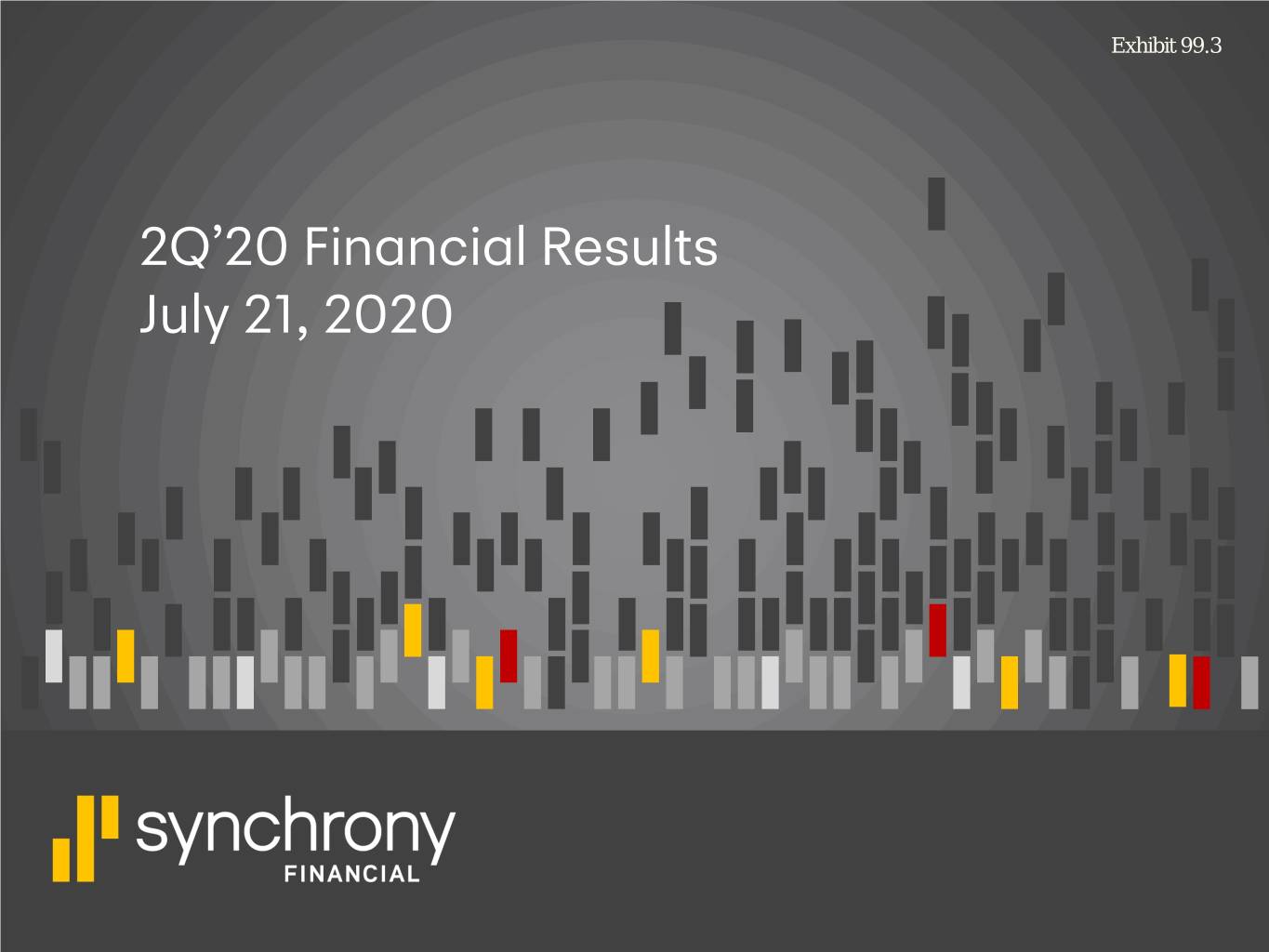
Exhibit 99.3 2Q’20 Financial Results July 21, 2020
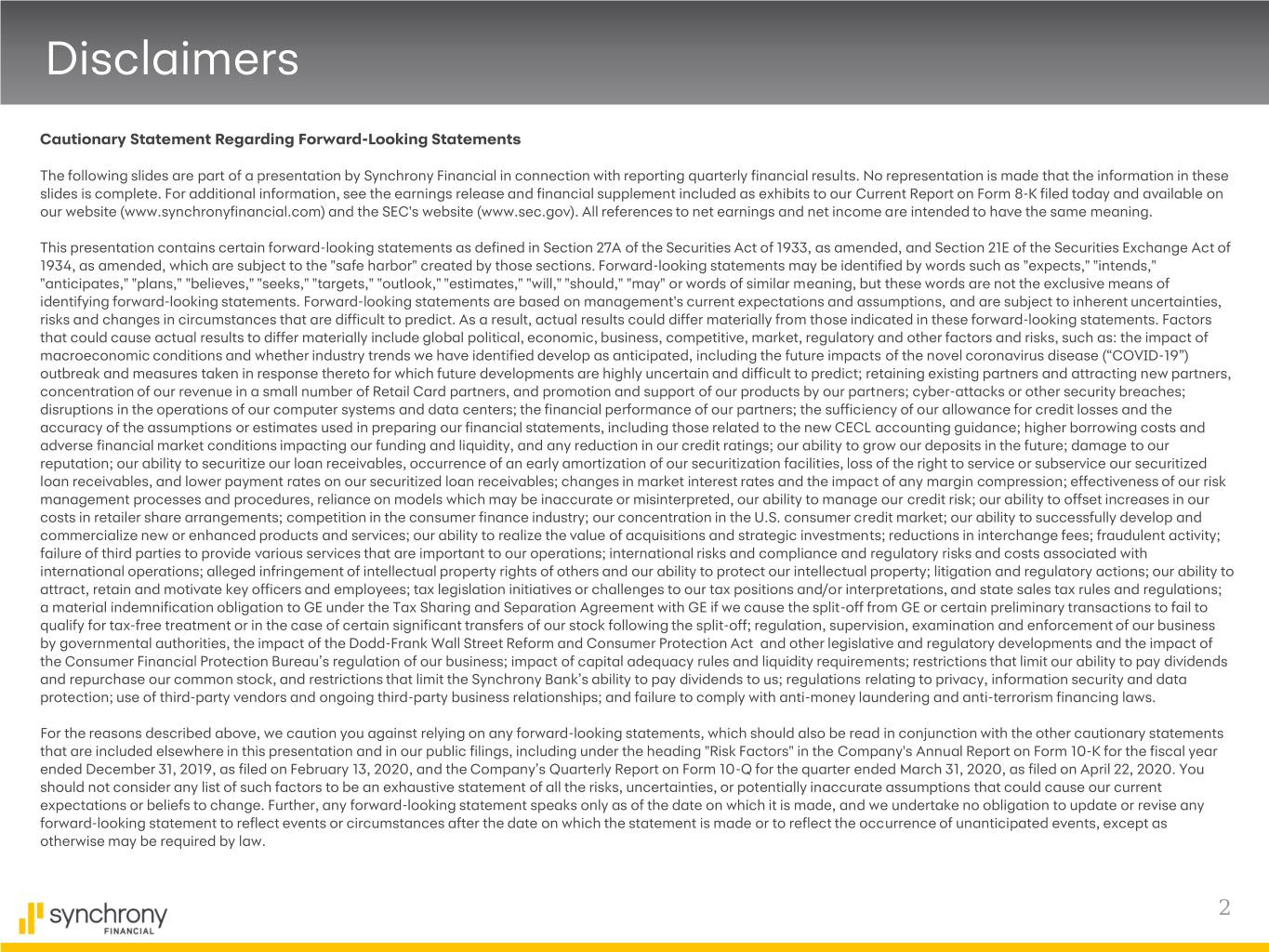
Disclaimers Cautionary Statement Regarding Forward-Looking Statements The following slides are part of a presentation by Synchrony Financial in connection with reporting quarterly financial results. No representation is made that the information in these slides is complete. For additional information, see the earnings release and financial supplement included as exhibits to our Current Report on Form 8-K filed today and available on our website (www.synchronyfinancial.com) and the SEC's website (www.sec.gov). All references to net earnings and net income are intended to have the same meaning. This presentation contains certain forward-looking statements as defined in Section 27A of the Securities Act of 1933, as amended, and Section 21E of the Securities Exchange Act of 1934, as amended, which are subject to the "safe harbor" created by those sections. Forward-looking statements may be identified by words such as "expects," "intends," "anticipates," "plans," "believes," "seeks," "targets," "outlook," "estimates," "will," "should," "may" or words of similar meaning, but these words are not the exclusive means of identifying forward-looking statements. Forward-looking statements are based on management's current expectations and assumptions, and are subject to inherent uncertainties, risks and changes in circumstances that are difficult to predict. As a result, actual results could differ materially from those indicated in these forward-looking statements. Factors that could cause actual results to differ materially include global political, economic, business, competitive, market, regulatory and other factors and risks, such as: the impact of macroeconomic conditions and whether industry trends we have identified develop as anticipated, including the future impacts of the novel coronavirus disease (“COVID-19”) outbreak and measures taken in response thereto for which future developments are highly uncertain and difficult to predict; retaining existing partners and attracting new partners, concentration of our revenue in a small number of Retail Card partners, and promotion and support of our products by our partners; cyber-attacks or other security breaches; disruptions in the operations of our computer systems and data centers; the financial performance of our partners; the sufficiency of our allowance for credit losses and the accuracy of the assumptions or estimates used in preparing our financial statements, including those related to the new CECL accounting guidance; higher borrowing costs and adverse financial market conditions impacting our funding and liquidity, and any reduction in our credit ratings; our ability to grow our deposits in the future; damage to our reputation; our ability to securitize our loan receivables, occurrence of an early amortization of our securitization facilities, loss of the right to service or subservice our securitized loan receivables, and lower payment rates on our securitized loan receivables; changes in market interest rates and the impact of any margin compression; effectiveness of our risk management processes and procedures, reliance on models which may be inaccurate or misinterpreted, our ability to manage our credit risk; our ability to offset increases in our costs in retailer share arrangements; competition in the consumer finance industry; our concentration in the U.S. consumer credit market; our ability to successfully develop and commercialize new or enhanced products and services; our ability to realize the value of acquisitions and strategic investments; reductions in interchange fees; fraudulent activity; failure of third parties to provide various services that are important to our operations; international risks and compliance and regulatory risks and costs associated with international operations; alleged infringement of intellectual property rights of others and our ability to protect our intellectual property; litigation and regulatory actions; our ability to attract, retain and motivate key officers and employees; tax legislation initiatives or challenges to our tax positions and/or interpretations, and state sales tax rules and regulations; a material indemnification obligation to GE under the Tax Sharing and Separation Agreement with GE if we cause the split-off from GE or certain preliminary transactions to fail to qualify for tax-free treatment or in the case of certain significant transfers of our stock following the split-off; regulation, supervision, examination and enforcement of our business by governmental authorities, the impact of the Dodd-Frank Wall Street Reform and Consumer Protection Act and other legislative and regulatory developments and the impact of the Consumer Financial Protection Bureau’s regulation of our business; impact of capital adequacy rules and liquidity requirements; restrictions that limit our ability to pay dividends and repurchase our common stock, and restrictions that limit the Synchrony Bank’s ability to pay dividends to us; regulations relating to privacy, information security and data protection; use of third-party vendors and ongoing third-party business relationships; and failure to comply with anti-money laundering and anti-terrorism financing laws. For the reasons described above, we caution you against relying on any forward-looking statements, which should also be read in conjunction with the other cautionary statements that are included elsewhere in this presentation and in our public filings, including under the heading "Risk Factors" in the Company's Annual Report on Form 10-K for the fiscal year ended December 31, 2019, as filed on February 13, 2020, and the Company’s Quarterly Report on Form 10-Q for the quarter ended March 31, 2020, as filed on April 22, 2020. You should not consider any list of such factors to be an exhaustive statement of all the risks, uncertainties, or potentially inaccurate assumptions that could cause our current expectations or beliefs to change. Further, any forward-looking statement speaks only as of the date on which it is made, and we undertake no obligation to update or revise any forward-looking statement to reflect events or circumstances after the date on which the statement is made or to reflect the occurrence of unanticipated events, except as otherwise may be required by law. 2
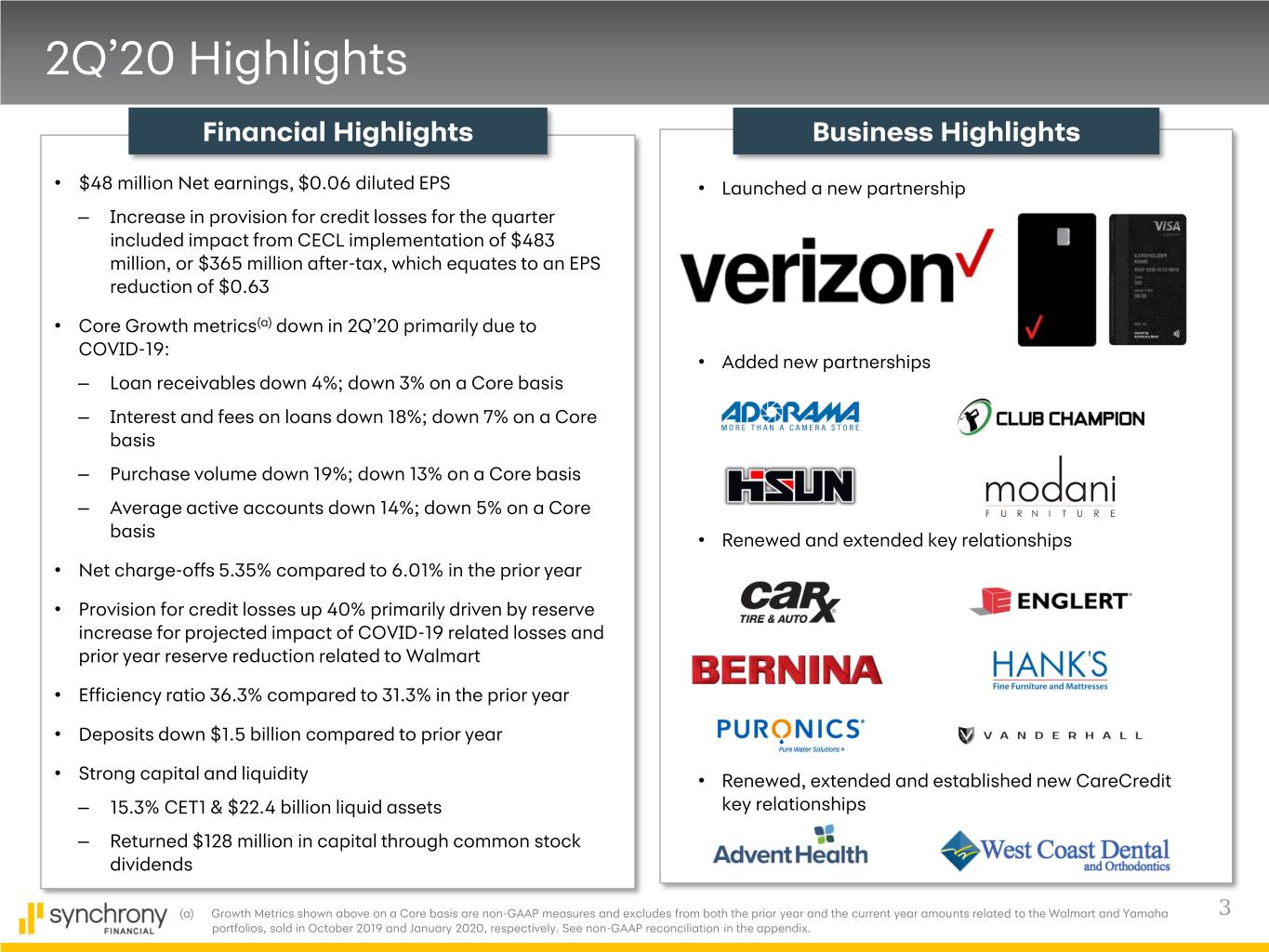
2Q’20 Highlights Financial Highlights Business Highlights • $48 million Net earnings, $0.06 diluted EPS • Launched a new partnership ‒ Increase in provision for credit losses for the quarter included impact from CECL implementation of $483 million, or $365 million after-tax, which equates to an EPS reduction of $0.63 • Core Growth metrics(a) down in 2Q’20 primarily due to COVID-19: • Added new partnerships ‒ Loan receivables down 4%; down 3% on a Core basis ‒ Interest and fees on loans down 18%; down 7% on a Core basis ‒ Purchase volume down 19%; down 13% on a Core basis ‒ Average active accounts down 14%; down 5% on a Core basis • Renewed and extended key relationships • Net charge-offs 5.35% compared to 6.01% in the prior year • Provision for credit losses up 40% primarily driven by reserve increase for projected impact of COVID-19 related losses and prior year reserve reduction related to Walmart • Efficiency ratio 36.3% compared to 31.3% in the prior year • Deposits down $1.5 billion compared to prior year • Strong capital and liquidity • Renewed, extended and established new CareCredit ‒ 15.3% CET1 & $22.4 billion liquid assets key relationships ‒ Returned $128 million in capital through common stock dividends (a) Growth Metrics shown above on a Core basis are non-GAAP measures and excludes from both the prior year and the current year amounts related to the Walmart and Yamaha 3 portfolios, sold in October 2019 and January 2020, respectively. See non-GAAP reconciliation in the appendix.
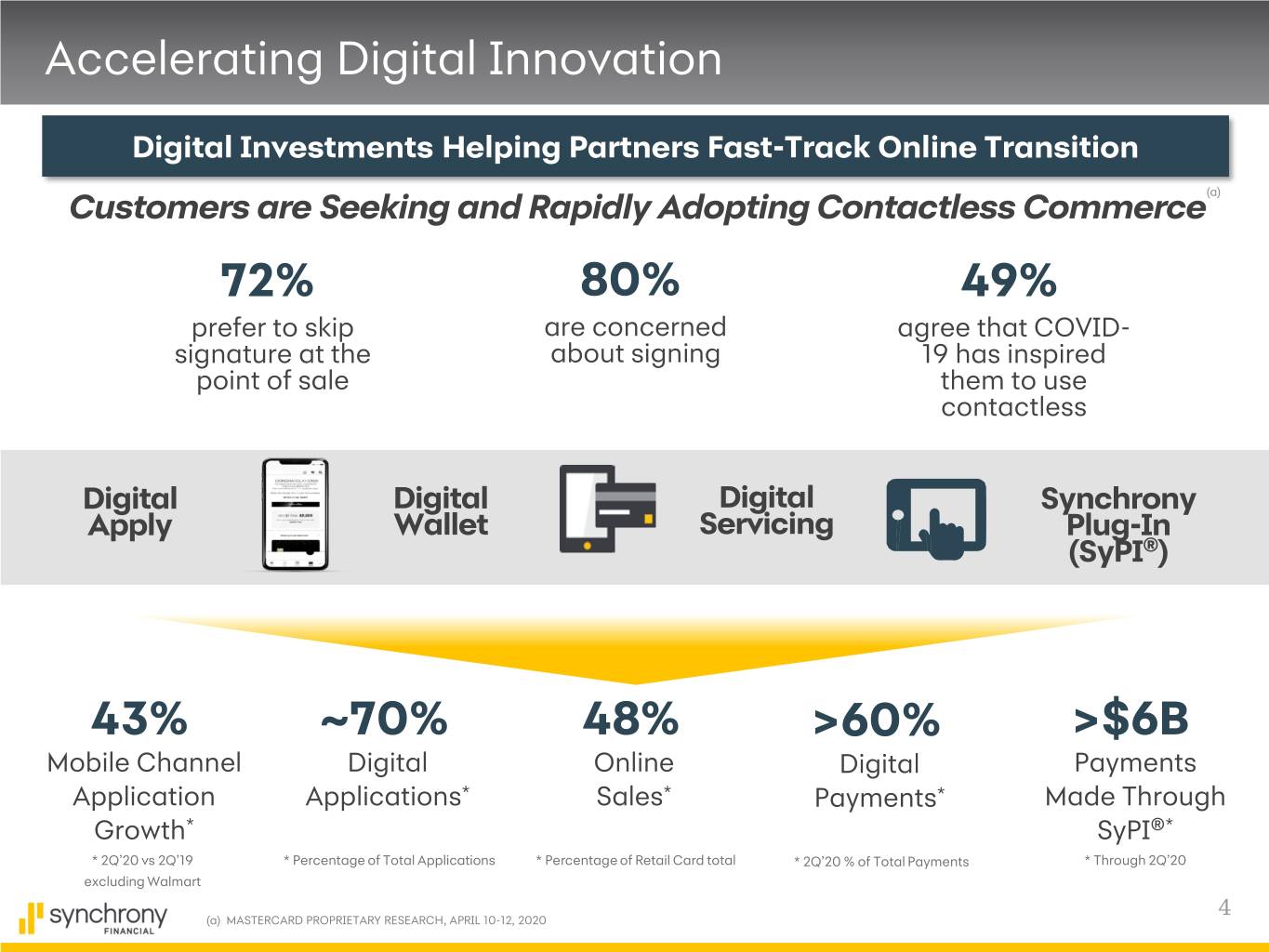
Accelerating Digital Innovation Digital Investments Helping Partners Fast-Track Online Transition Customers are Seeking and Rapidly Adopting Contactless Commerce (a) 72% 80% 49% prefer to skip are concerned agree that COVID- signature at the about signing 19 has inspired point of sale them to use contactless Digital Digital Digital Synchrony Apply Wallet Servicing Plug-In (SyPI®) 43% ~70% 48% >60% >$6B Mobile Channel Digital Online Digital Payments Application Applications* Sales* Payments* Made Through Growth* SyPI®* * 2Q’20 vs 2Q’19 * Percentage of Total Applications * Percentage of Retail Card total * 2Q’20 % of Total Payments * Through 2Q’20 excluding Walmart 4 (a) MASTERCARD PROPRIETARY RESEARCH, APRIL 10-12, 2020

COVID-19 Impact on Core Metrics (a) Purchase Volume Growth New Accounts (b) % in YoY Growth Rates 6.2 (36)% Mar 1-17 Mar 18-31 Apr 1-15 Apr 16-30 May 1-15 May 16-31 Jun 1 -15 Jun 16-30 4.0 14% 3% (4)% 2Q'19 2Q'20 (9)% (15)% (c) (23)% (26)% Purchase Volume per Account (31)% (8)% $524 $481 Platform Purchase Volume Growth % in YoY Growth Rates Jan Feb Mar Apr May Jun 10% 13% 0% Retail Card 2Q'19 2Q'20 (2)% (9)% (d) (21)% Average Balance per Account 13% 10% 1% Payment $1,164 $1,214 4% Solutions (11)% (15)% (41)% 14% 18% CareCredit (4)% (22)% (29)% (60)% 2Q'19 2Q'20 (a) All metrics exclude from both the prior year and the current year amounts related to the Walmart and Yamaha portfolios, sold in October 2019 and January 2020, respectively. (b) New Accounts represent accounts that were approved in the respective period in millions. 5 (c) Purchase Volume per Account is calculated as the Purchase volume divided by Average active accounts, in $. (d) Average Balance per Account is calculated as the Average loan receivables divided by Average active accounts, in $.

COVID Forbearance Impact – Program-to-Date through June 30th Min Pay Due (MPD) Performance Statistics Fee Waivers $ in millions Enrollments 56% $ in millions, accounts in thousands $47 $3,178 Program-to-Date Enrolled At June 30, 2020 Never Enrolled 27% 1,655 $20 $1,075 16% 509 6% Balance Accounts Credit Line Utilization Payment Rate Late Fees Interest Charges MPD Enrollment by Payment Behavior of Credit Score (b) (a) Date and Delinquency Enrolled Accounts 11% 40 35 40% 33% 30 8% Thousands 25 31% 20 34% 36% 15 61% 10 17% 5 22% 0 7% No Pay Currently Enrolled Not Enrolled Pay Less than Full Balance Current & < 30 days past due 30+ days past due Pay Balance in Full < 600 601-660 661-720 721+ (a) Reflects June performance for percent of accounts by payment status ever enrolled in the program. (b) Based on most recent FICO scores available for our customers in each period, weighted by balance, as a % of period-end receivables. If FICO score was not available, credit 6 bureau-based scores were mapped to a FICO equivalent. If neither score was available, the account was excluded.
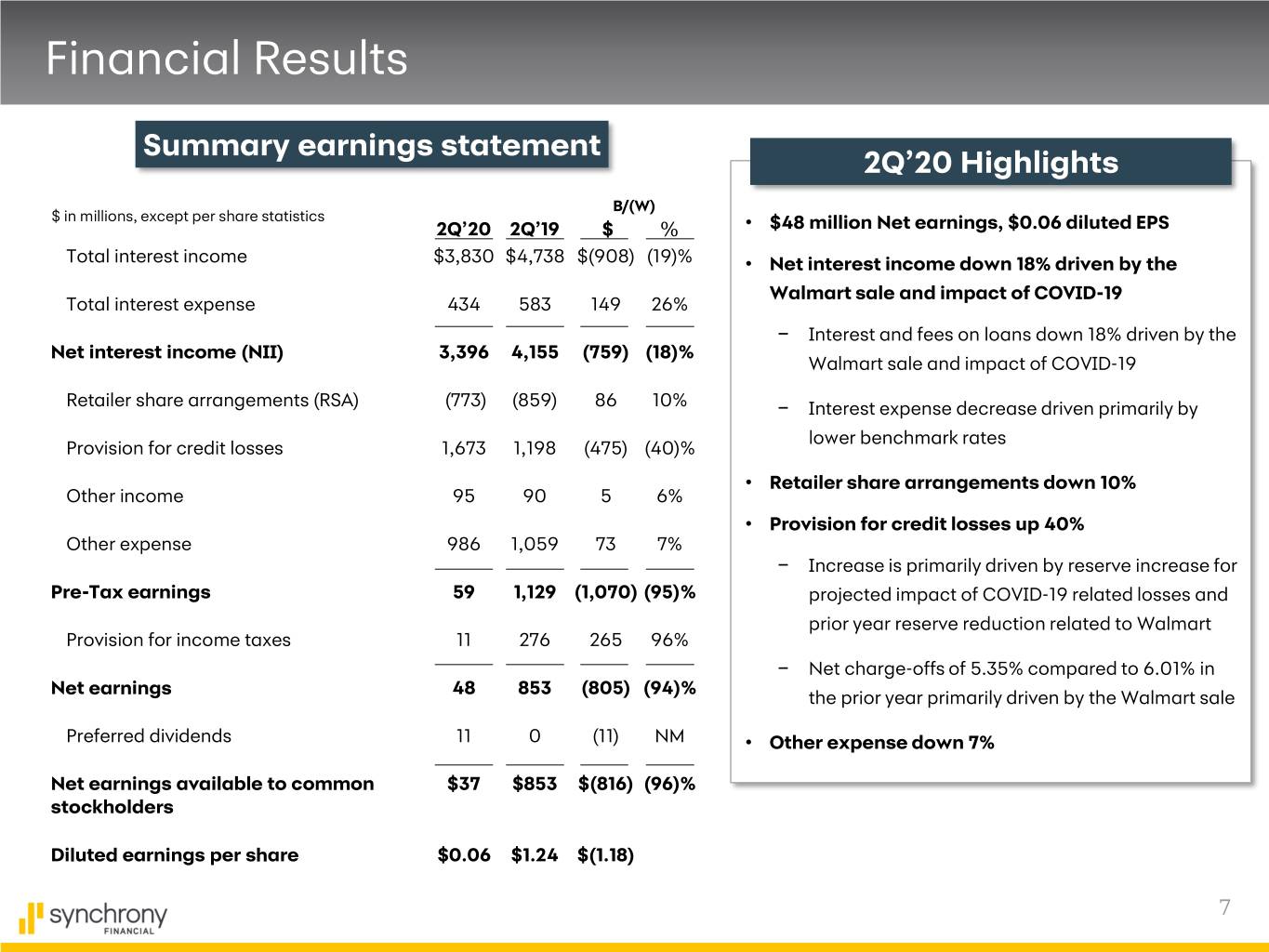
Financial Results Summary earnings statement 2Q’20 Highlights B/(W) $ in millions, except per share statistics 2Q’20 2Q’19 $ % • $48 million Net earnings, $0.06 diluted EPS Total interest income $3,830 $4,738 $(908) (19)% • Net interest income down 18% driven by the Walmart sale and impact of COVID-19 Total interest expense 434 583 149 26% − Interest and fees on loans down 18% driven by the Net interest income (NII) 3,396 4,155 (759) (18)% Walmart sale and impact of COVID-19 Retailer share arrangements (RSA) (773) (859) 86 10% − Interest expense decrease driven primarily by lower benchmark rates Provision for credit losses 1,673 1,198 (475) (40)% • Retailer share arrangements down 10% Other income 95 90 5 6% • Provision for credit losses up 40% Other expense 986 1,059 73 7% − Increase is primarily driven by reserve increase for Pre-Tax earnings 59 1,129 (1,070) (95)% projected impact of COVID-19 related losses and prior year reserve reduction related to Walmart Provision for income taxes 11 276 265 96% − Net charge-offs of 5.35% compared to 6.01% in Net earnings 48 853 (805) (94)% the prior year primarily driven by the Walmart sale Preferred dividends 11 0 (11) NM • Other expense down 7% Net earnings available to common $37 $853 $(816) (96)% stockholders Diluted earnings per share $0.06 $1.24 $(1.18) 7

Growth Metrics Purchase volume (19)% Loan receivables (4)% $ in billions $ in billions $38.3 $81.8 $78.3 $31.2 Core (a) $35.8 $31.2 (13)% Core (a) $80.6 $78.3 (3)% 2Q'19 2Q'20 2Q'19 2Q'20 Dual Card / Dual Card / (b) $13.4 $10.4 (22)% (b) $19.2 $18.4 (4)% Co-Brand Co-Brand Average active accounts (14)% Interest and fees on loans (18)% in millions $ in millions 75.5 $4,636 64.8 $3,808 Core (a) 68.3 64.8 (5)% Core (a) $4,116 $3,808 (7)% 2Q'19 2Q'20 2Q'19 2Q'20 a) Financial measures shown above on a Core basis are non-GAAP measures. See non-GAAP reconciliation in the appendix. b) Dual Card / Co-Brand Purchase volume and Loan receivables shown above are consumer only and excludes from the prior year amounts related to the Walmart portfolio. 8
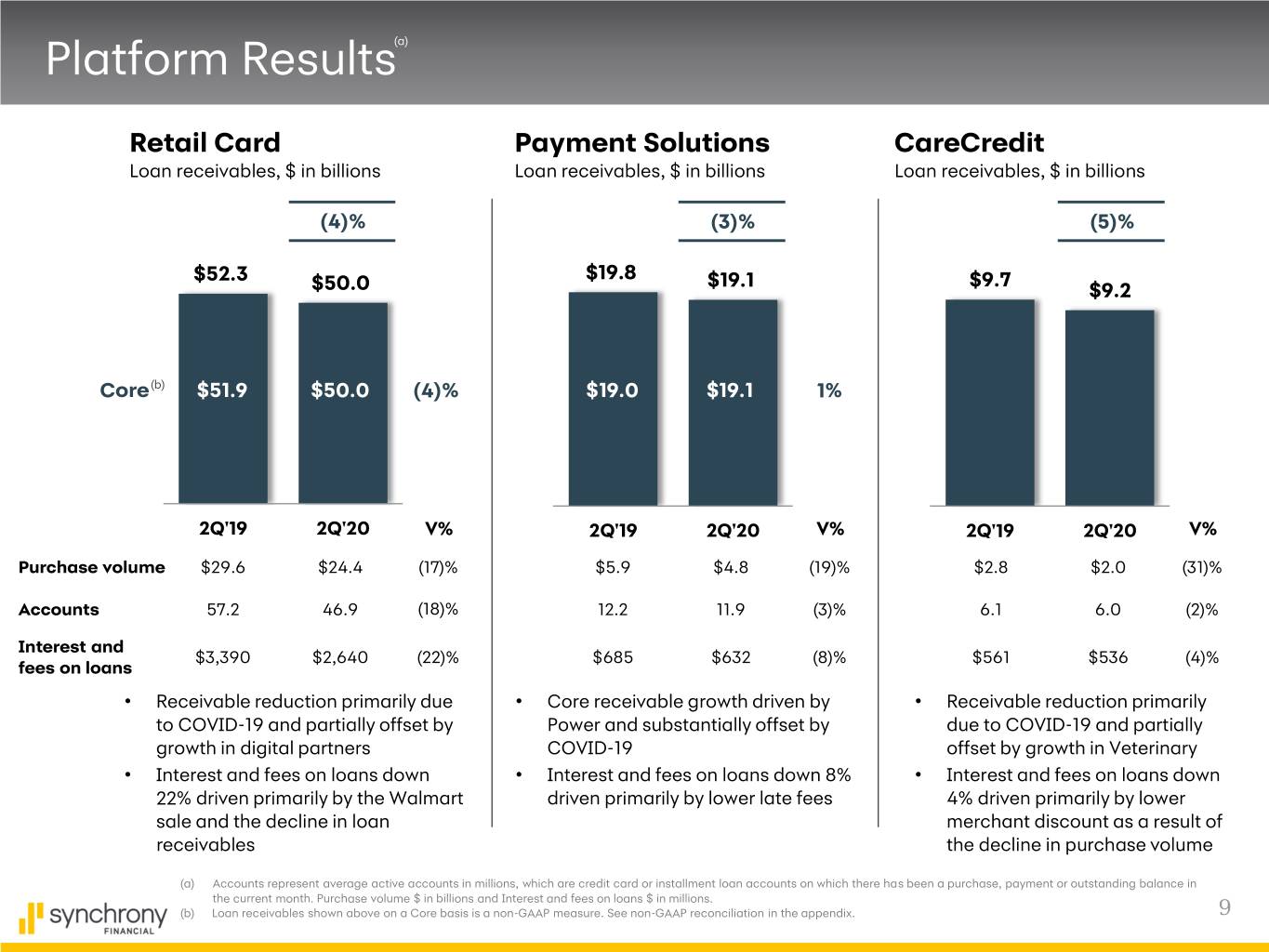
Platform Results(a) Retail Card Payment Solutions CareCredit Loan receivables, $ in billions Loan receivables, $ in billions Loan receivables, $ in billions (4)% (3)% (5)% $52.3 $19.8 $9.7 $50.0 $19.1 $9.2 Core(b) $51.9 $50.0 (4)% $19.0 $19.1 1% 2Q'19 2Q'20 V% 2Q'19 2Q'20 V% 2Q'19 2Q'20 V% Purchase volume $29.6 $24.4 (17)% $5.9 $4.8 (19)% $2.8 $2.0 (31)% Accounts 57.2 46.9 (18)% 12.2 11.9 (3)% 6.1 6.0 (2)% Interest and $3,390 $2,640 (22)% $685 $632 (8)% $561 $536 (4)% fees on loans • Receivable reduction primarily due • Core receivable growth driven by • Receivable reduction primarily to COVID-19 and partially offset by Power and substantially offset by due to COVID-19 and partially growth in digital partners COVID-19 offset by growth in Veterinary • Interest and fees on loans down • Interest and fees on loans down 8% • Interest and fees on loans down 22% driven primarily by the Walmart driven primarily by lower late fees 4% driven primarily by lower sale and the decline in loan merchant discount as a result of receivables the decline in purchase volume (a) Accounts represent average active accounts in millions, which are credit card or installment loan accounts on which there has been a purchase, payment or outstanding balance in the current month. Purchase volume $ in billions and Interest and fees on loans $ in millions. (b) Loan receivables shown above on a Core basis is a non-GAAP measure. See non-GAAP reconciliation in the appendix. 9
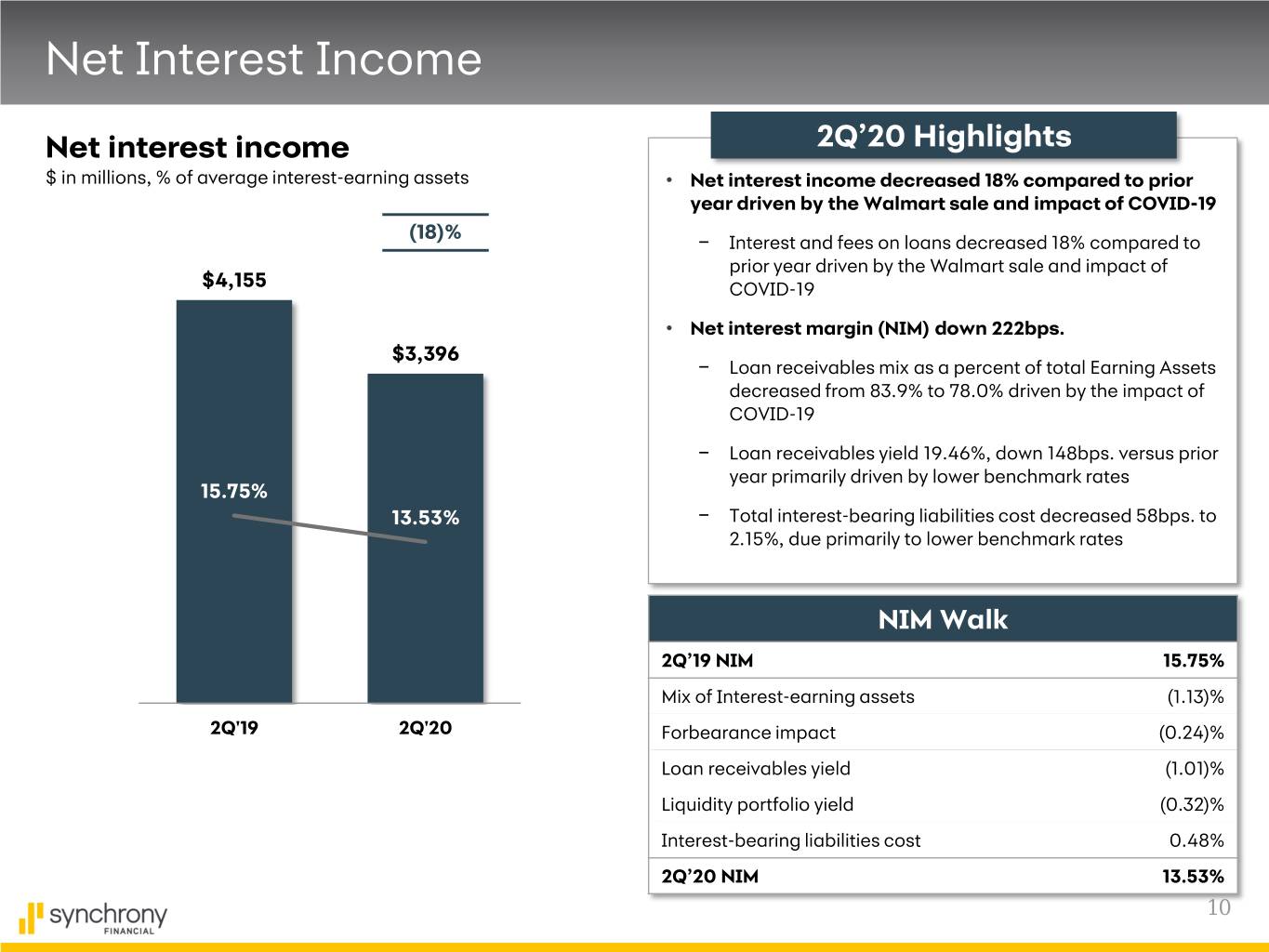
Net Interest Income Net interest income 2Q’20 Highlights $ in millions, % of average interest-earning assets • Net interest income decreased 18% compared to prior year driven by the Walmart sale and impact of COVID-19 (18)% − Interest and fees on loans decreased 18% compared to prior year driven by the Walmart sale and impact of $4,155 COVID-19 • Net interest margin (NIM) down 222bps. $3,396 − Loan receivables mix as a percent of total Earning Assets decreased from 83.9% to 78.0% driven by the impact of COVID-19 − Loan receivables yield 19.46%, down 148bps. versus prior year primarily driven by lower benchmark rates 15.75% 13.53% − Total interest-bearing liabilities cost decreased 58bps. to 2.15%, due primarily to lower benchmark rates NIM Walk 2Q’19 NIM 15.75% Mix of Interest-earning assets (1.13)% 2Q'19 2Q'20 Forbearance impact (0.24)% Loan receivables yield (1.01)% Liquidity portfolio yield (0.32)% Interest-bearing liabilities cost 0.48% 2Q’20 NIM 13.53% 10
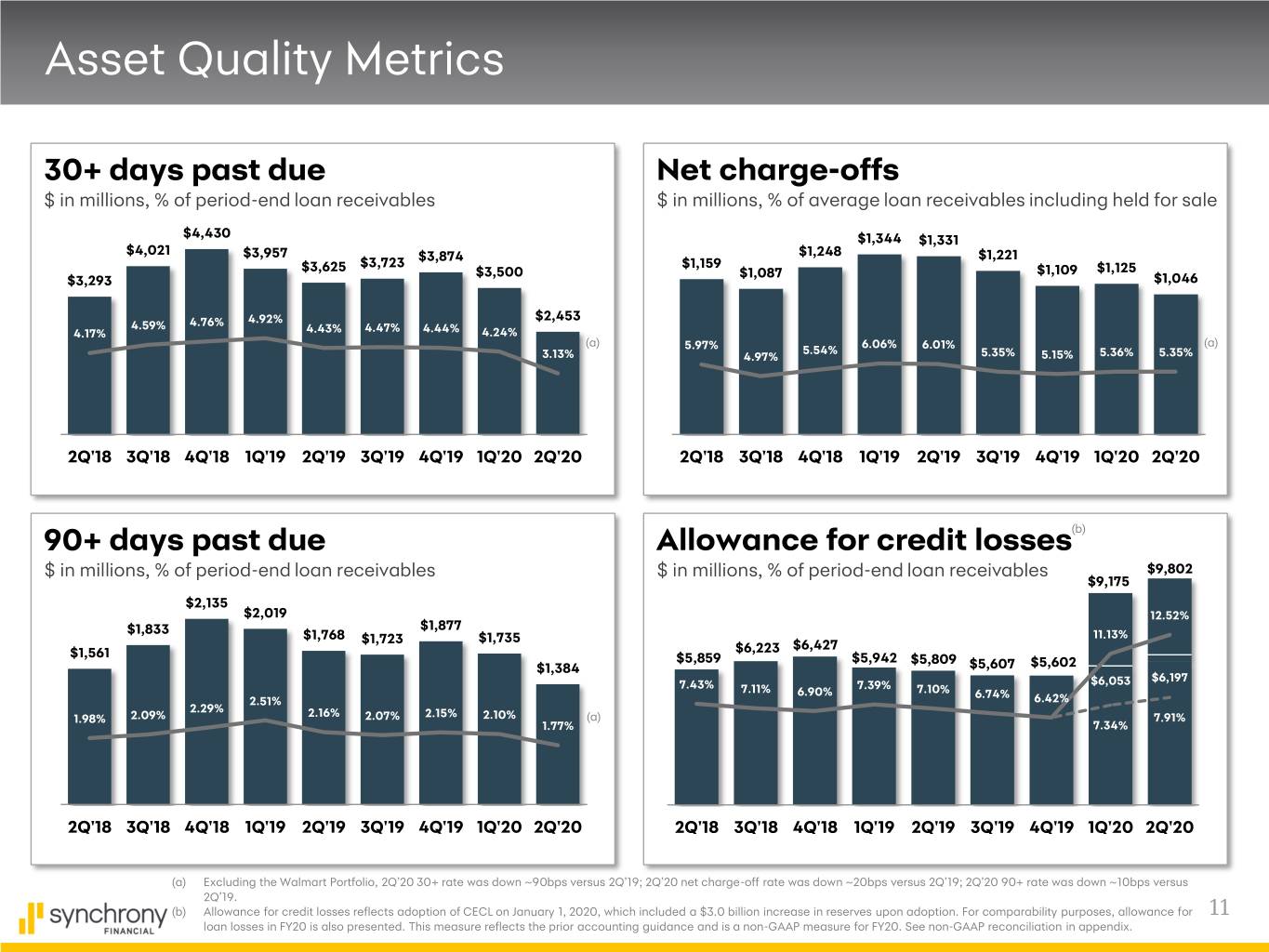
Asset Quality Metrics 30+ days past due Net charge-offs $ in millions, % of period-end loan receivables $ in millions, % of average loan receivables including held for sale $4,430 $1,344 $1,331 $4,021 $3,957 $1,248 $1,221 $3,723 $3,874 $1,159 $3,625 $3,500 $1,087 $1,109 $1,125 $3,293 $1,046 4.92% $2,453 4.59% 4.76% 4.17% 4.43% 4.47% 4.44% 4.24% (a) (a) 5.97% 5.54% 6.06% 6.01% 3.13% 4.97% 5.35% 5.15% 5.36% 5.35% 2Q'18 3Q'18 4Q'18 1Q'19 2Q'19 3Q'19 4Q'19 1Q'20 2Q'20 2Q'18 3Q'18 4Q'18 1Q'19 2Q'19 3Q'19 4Q'19 1Q'20 2Q'20 90+ days past due Allowance for credit losses(b) $ in millions, % of period-end loan receivables $ in millions, % of period-end loan receivables $9,802 $9,175 $2,135 $2,019 12.52% $1,833 $1,877 $1,768 $1,723 $1,735 11.13% $6,223 $6,427 $1,561 $5,859 $5,942 $5,809 $1,384 $5,607 $5,602 $6,197 7.43% 7.39% $6,053 7.11% 6.90% 7.10% 6.74% 2.51% 6.42% 2.29% 1.98% 2.09% 2.16% 2.07% 2.15% 2.10% (a) 7.91% 1.77% 7.34% 2Q'18 3Q'18 4Q'18 1Q'19 2Q'19 3Q'19 4Q'19 1Q'20 2Q'20 2Q'18 3Q'18 4Q'18 1Q'19 2Q'19 3Q'19 4Q'19 1Q'20 2Q'20 (a) Excluding the Walmart Portfolio, 2Q’20 30+ rate was down ~90bps versus 2Q’19; 2Q’20 net charge-off rate was down ~20bps versus 2Q’19; 2Q’20 90+ rate was down ~10bps versus 2Q’19. (b) Allowance for credit losses reflects adoption of CECL on January 1, 2020, which included a $3.0 billion increase in reserves upon adoption. For comparability purposes, allowance for 11 loan losses in FY20 is also presented. This measure reflects the prior accounting guidance and is a non-GAAP measure for FY20. See non-GAAP reconciliation in appendix.
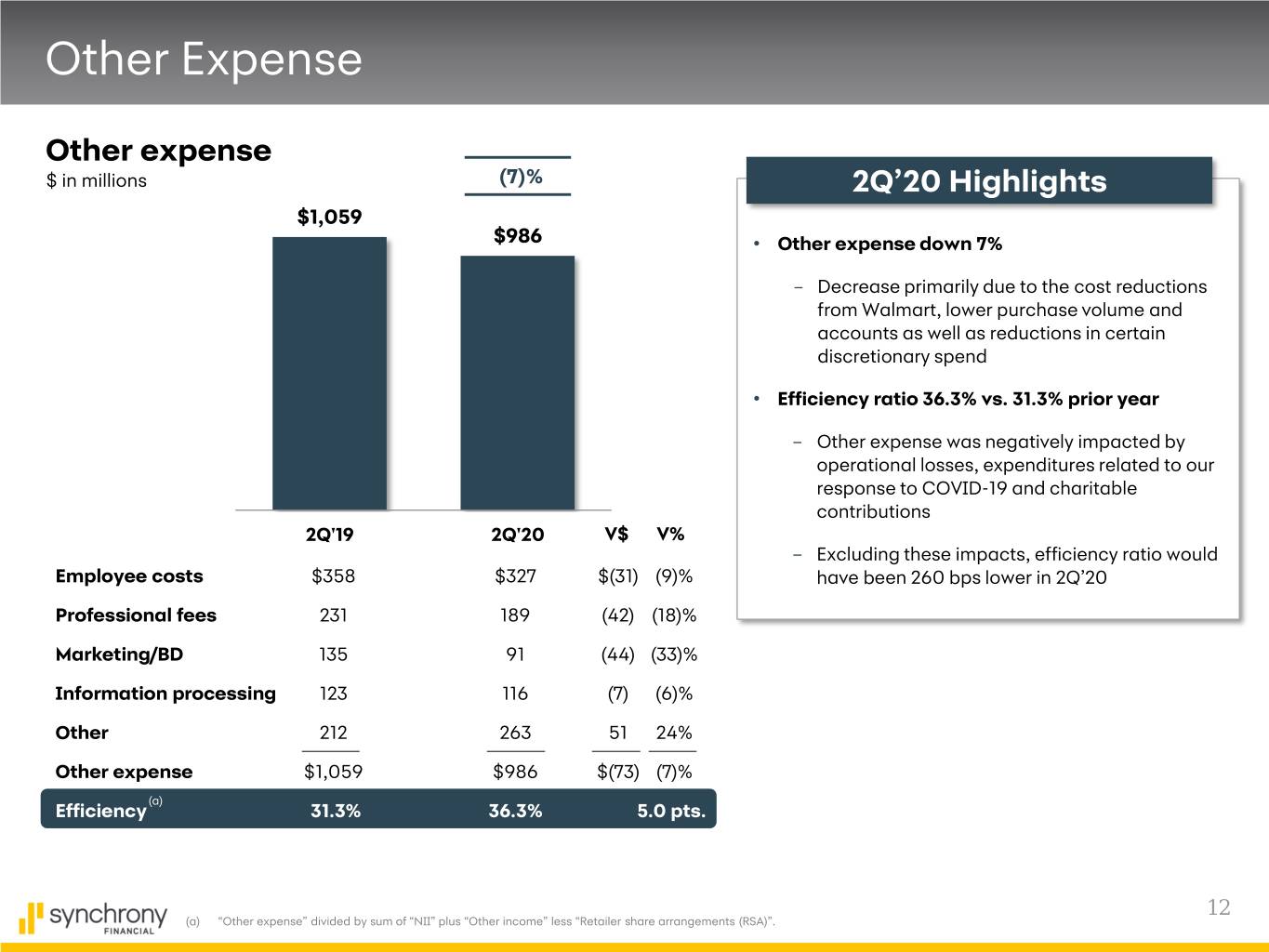
Other Expense Other expense $ in millions (7)% 2Q’20 Highlights $1,059 $986 • Other expense down 7% – Decrease primarily due to the cost reductions from Walmart, lower purchase volume and accounts as well as reductions in certain discretionary spend • Efficiency ratio 36.3% vs. 31.3% prior year – Other expense was negatively impacted by operational losses, expenditures related to our response to COVID-19 and charitable contributions 2Q'19 2Q'20 V$ V% – Excluding these impacts, efficiency ratio would Employee costs $358 $327 $(31) (9)% have been 260 bps lower in 2Q’20 Professional fees 231 189 (42) (18)% Marketing/BD 135 91 (44) (33)% Information processing 123 116 (7) (6)% Other 212 263 51 24% Other expense $1,059 $986 $(73) (7)% (a) Efficiency 31.3% 36.3% 5.0 pts. 12 (a) “Other expense” divided by sum of “NII” plus “Other income” less “Retailer share arrangements (RSA)”.
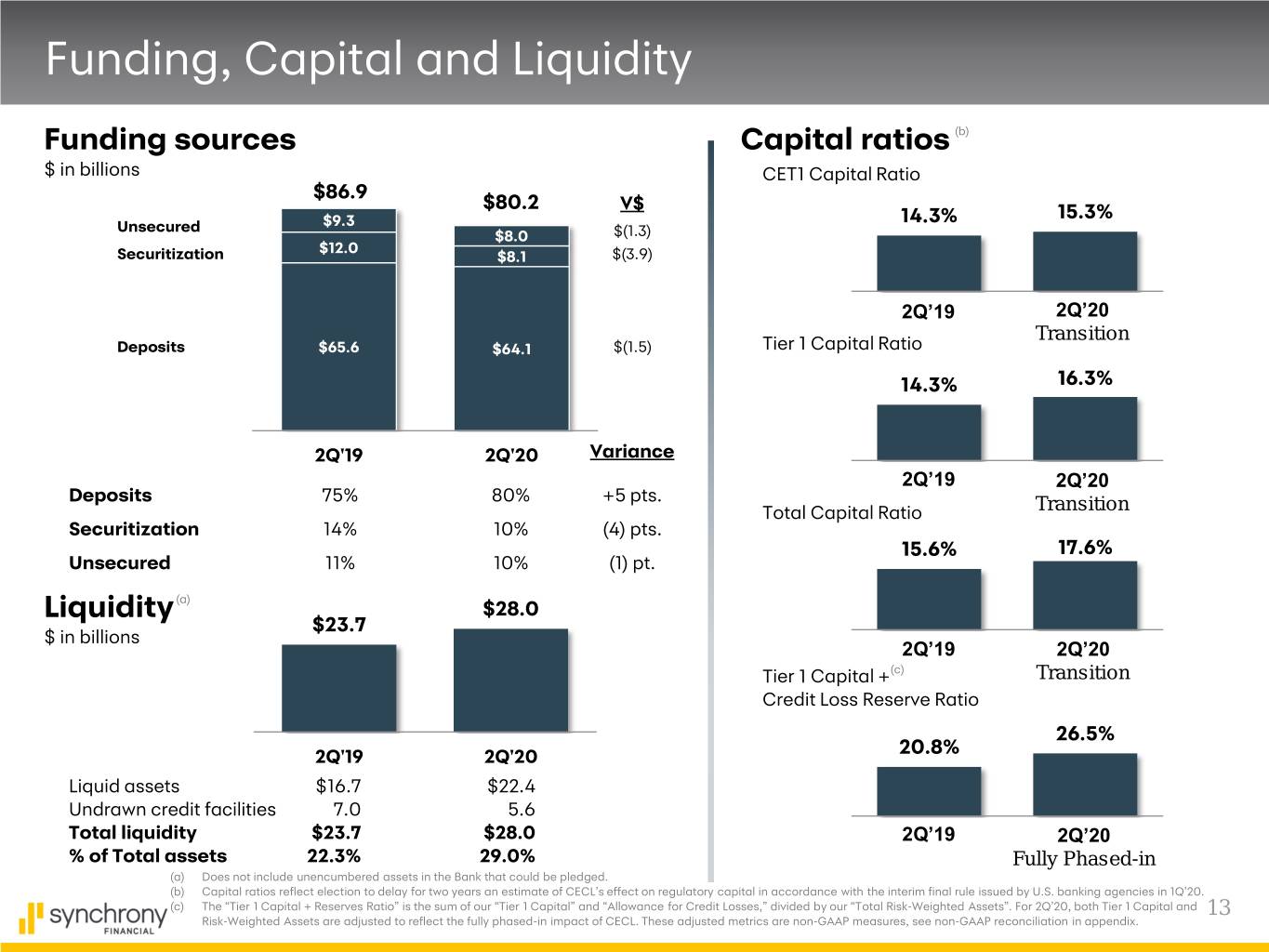
Funding, Capital and Liquidity Funding sources Capital ratios (b) $ in billions CET1 Capital Ratio $86.9 $80.2 V$ 14.3% 15.3% Unsecured $9.3 $8.0 $(1.3) $12.0 Securitization $8.1 $(3.9) 2Q’19 2Q’20 Transition Deposits $65.6 $64.1 $(1.5) Tier 1 Capital Ratio 14.3% 16.3% 2Q'19 2Q'20 Variance 2Q’19 2Q’20 Deposits 75% 80% +5 pts. Total Capital Ratio Transition Securitization 14% 10% (4) pts. 15.6% 17.6% Unsecured 11% 10% (1) pt. Liquidity (a) $28.0 $23.7 $ in billions 2Q’19 2Q’20 Tier 1 Capital + (c) Transition Credit Loss Reserve Ratio 26.5% 2Q'19 2Q'20 20.8% Liquid assets $16.7 $22.4 Undrawn credit facilities 7.0 5.6 Total liquidity $23.7 $28.0 2Q’19 2Q’20 % of Total assets 22.3% 29.0% Fully Phased-in (a) Does not include unencumbered assets in the Bank that could be pledged. (b) Capital ratios reflect election to delay for two years an estimate of CECL’s effect on regulatory capital in accordance with the interim final rule issued by U.S. banking agencies in 1Q’20. (c) The “Tier 1 Capital + Reserves Ratio” is the sum of our “Tier 1 Capital” and “Allowance for Credit Losses,” divided by our “Total Risk-Weighted Assets”. For 2Q’20, both Tier 1 Capital and 13 Risk-Weighted Assets are adjusted to reflect the fully phased-in impact of CECL. These adjusted metrics are non-GAAP measures, see non-GAAP reconciliation in appendix.
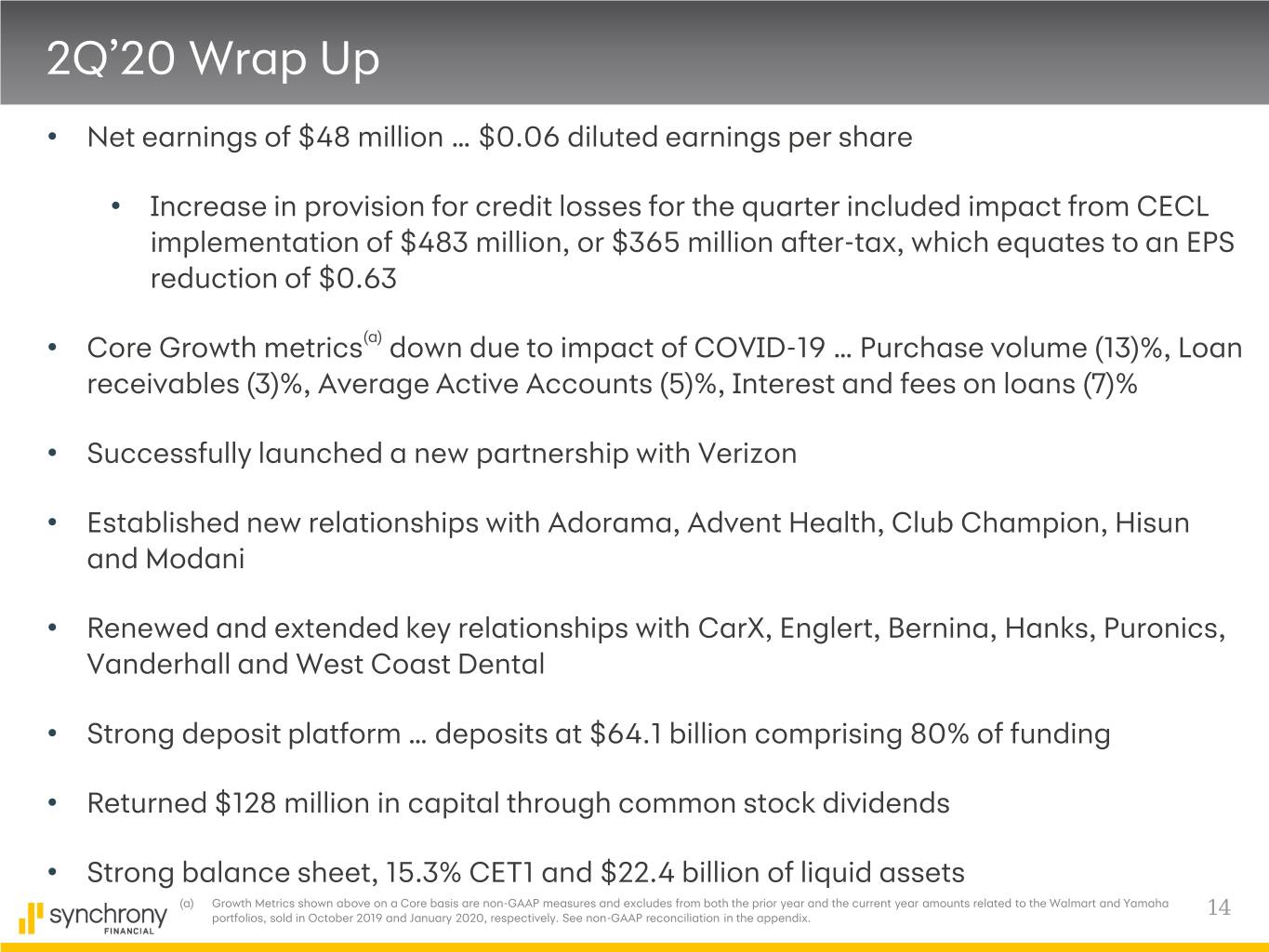
2Q’20 Wrap Up • Net earnings of $48 million … $0.06 diluted earnings per share • Increase in provision for credit losses for the quarter included impact from CECL implementation of $483 million, or $365 million after-tax, which equates to an EPS reduction of $0.63 • Core Growth metrics(a) down due to impact of COVID-19 … Purchase volume (13)%, Loan receivables (3)%, Average Active Accounts (5)%, Interest and fees on loans (7)% • Successfully launched a new partnership with Verizon • Established new relationships with Adorama, Advent Health, Club Champion, Hisun and Modani • Renewed and extended key relationships with CarX, Englert, Bernina, Hanks, Puronics, Vanderhall and West Coast Dental • Strong deposit platform … deposits at $64.1 billion comprising 80% of funding • Returned $128 million in capital through common stock dividends • Strong balance sheet, 15.3% CET1 and $22.4 billion of liquid assets (a) Growth Metrics shown above on a Core basis are non-GAAP measures and excludes from both the prior year and the current year amounts related to the Walmart and Yamaha portfolios, sold in October 2019 and January 2020, respectively. See non-GAAP reconciliation in the appendix. 14

Engage with us.

Appendix 16
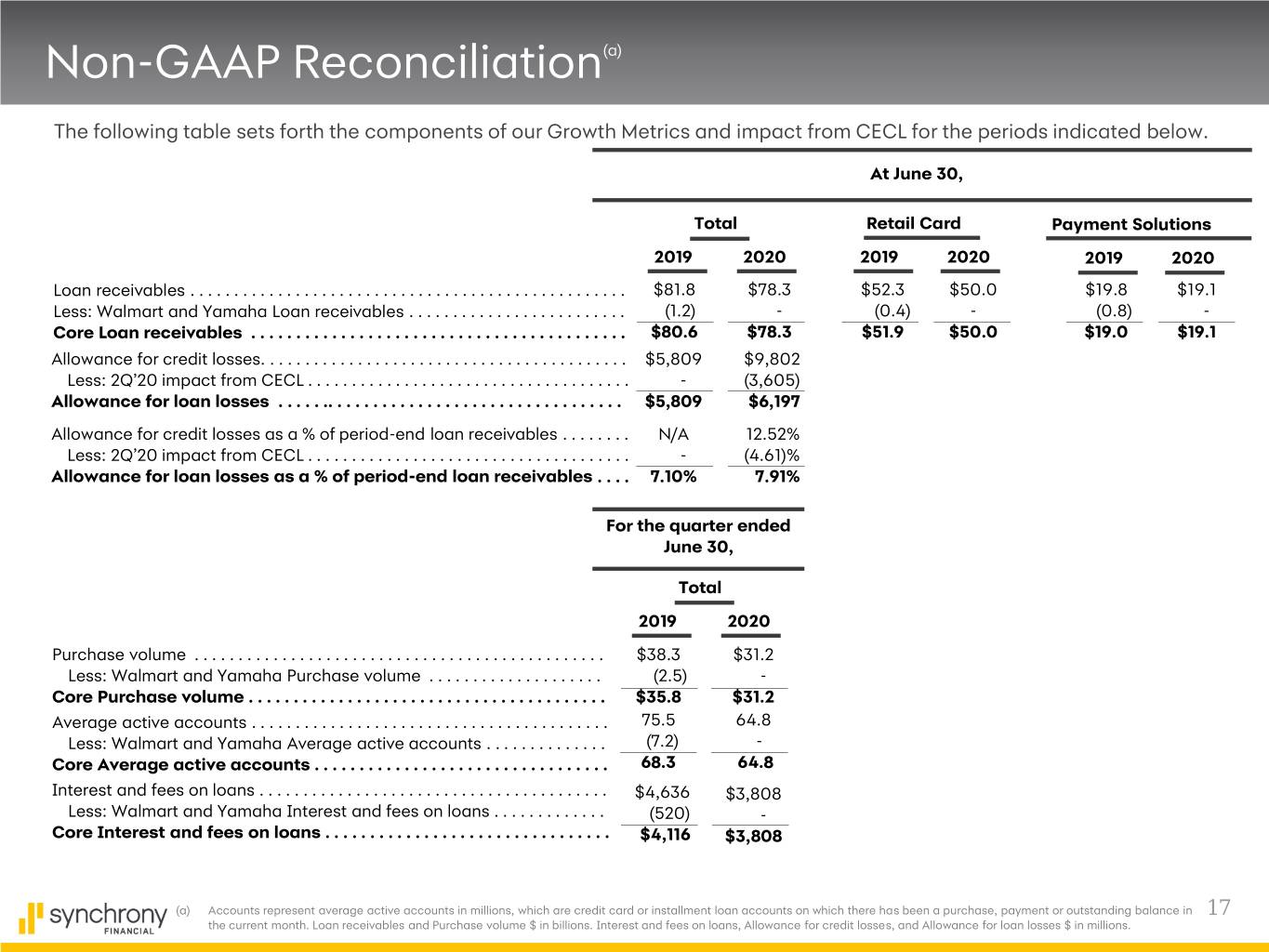
Non-GAAP Reconciliation(a) The following table sets forth the components of our Growth Metrics and impact from CECL for the periods indicated below. At June 30, Total Retail Card Payment Solutions 2019 2020 2019 2020 2019 2020 Loan receivables . . . . . . . . . . . . . . . . . . . . . . . . . . . . . . . . . . . . . . . . . . . . . . . . . . $81.8 $78.3 $52.3 $50.0 $19.8 $19.1 Less: Walmart and Yamaha Loan receivables . . . . . . . . . . . . . . . . . . . . . . . . . (1.2) - (0.4) - (0.8) - Core Loan receivables . . . . . . . . . . . . . . . . . . . . . . . . . . . . . . . . . . . . . . . . . . $80.6 $78.3 $51.9 $50.0 $19.0 $19.1 Allowance for credit losses. . . . . . . . . . . . . . . . . . . . . . . . . . . . . . . . . . . . . . . . . . $5,809 $9,802 Less: 2Q’20 impact from CECL . . . . . . . . . . . . . . . . . . . . . . . . . . . . . . . . . . . . . - (3,605) Allowance for loan losses . . . . . .. . . . . . . . . . . . . . . . . . . . . . . . . . . . . . . . . $5,809 $6,197 Allowance for credit losses as a % of period-end loan receivables . . . . . . . . N/A 12.52% Less: 2Q’20 impact from CECL . . . . . . . . . . . . . . . . . . . . . . . . . . . . . . . . . . . . . - (4.61)% Allowance for loan losses as a % of period-end loan receivables . . . . 7.10% 7.91% For the quarter ended June 30, Total 2019 2020 Purchase volume . . . . . . . . . . . . . . . . . . . . . . . . . . . . . . . . . . . . . . . . . . . . . . . $38.3 $31.2 Less: Walmart and Yamaha Purchase volume . . . . . . . . . . . . . . . . . . . . (2.5) - Core Purchase volume . . . . . . . . . . . . . . . . . . . . . . . . . . . . . . . . . . . . . . . . $35.8 $31.2 Average active accounts . . . . . . . . . . . . . . . . . . . . . . . . . . . . . . . . . . . . . . . . . 75.5 64.8 Less: Walmart and Yamaha Average active accounts . . . . . . . . . . . . . . (7.2) - Core Average active accounts . . . . . . . . . . . . . . . . . . . . . . . . . . . . . . . . . 68.3 64.8 Interest and fees on loans . . . . . . . . . . . . . . . . . . . . . . . . . . . . . . . . . . . . . . . . $4,636 $3,808 Less: Walmart and Yamaha Interest and fees on loans . . . . . . . . . . . . . (520) - Core Interest and fees on loans . . . . . . . . . . . . . . . . . . . . . . . . . . . . . . . . $4,116 $3,808 (a) Accounts represent average active accounts in millions, which are credit card or installment loan accounts on which there has been a purchase, payment or outstanding balance in 17 the current month. Loan receivables and Purchase volume $ in billions. Interest and fees on loans, Allowance for credit losses, and Allowance for loan losses $ in millions.

Non-GAAP Reconciliation (continued)(a) The following table sets forth the components of our Tier 1 Capital + Reserves ratio for the periods indicated below. At June 30, Total 2019 2020 Tier 1 capital. . . . . . . . . . . . . . . . . . . . . . . . . . . . . . . . . . . . . . . . . . . . . . . . . . . . . . . $12,724 $12,527 Less: CECL transition adjustment. . . . . . . . . . . . . . . . . . . . . . . . . . . . . . . . . . . . . - (2,570) Tier 1 capital (CECL fully phased-in) . . . . . . . . . . . . . . . . . . . . . . . . . . . . . . . $12,724 $9,957 Add: Allowance for credit losses . . . . . . . . . . . . . . . . . . . . . . . . . . . . . . . . . . . . 5,809 9,802 Tier 1 capital (CECL fully phased-in) plus Reserves for credit losses. $18,533 $19,759 Risk-weighted assets . . . . . . . . . . . . . . . . . . . . . . . . . . . . . . . . . . . . . . . . . . . $88,890 $77,048 Less: CECL transition adjustment . . . . . . . . . . . . . . . . . . . . . . . . . . . . . . . . . . . . - (2,361) Risk-weighted assets (CECL fully phased-in) . . . . . . . . . . . . . . . . . . . . . . $88,890 $74,687 (a) Estimated at June 30, 2020, $ in millions. 18